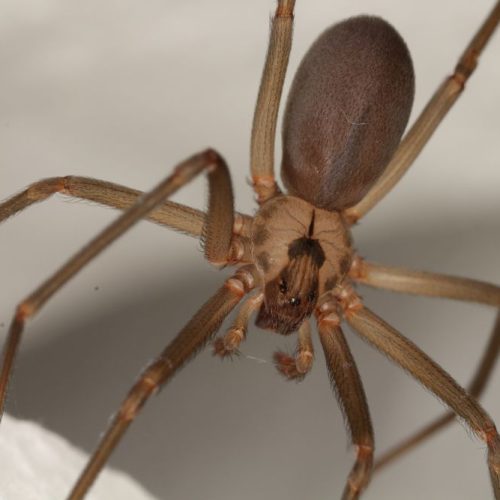How to Protect Your Home from Brown Recluse Spiders
The brown recluse spider, known scientifically as Loxosceles reclusa, is a common yet often feared inhabitant of Missouri homes. Recognized by the distinctive violin-shaped mark on its back, this spider can pose significant health risks if disturbed. Understanding their habitat, behavior, and prevention methods is crucial for homeowners seeking to safeguard their homes against these unwelcome guests.
Brown Recluse Spider Habitat in Missouri
Indoor Habitat
Brown recluse spiders prefer undisturbed, seldom-used areas within homes. You can often find them in:
- Boxes:
Especially those stored in basements, attics, or closets. - Underneath Furniture:
Tables, chairs, and other items that are not frequently moved. - Closets and Storage Areas:
Seldom-used clothing and shoes are prime hiding spots. - Attics and Crawlspaces:
Dark, secluded environments are ideal for these spiders. - Basements:
Particularly in corners and under items that are rarely disturbed.
Outdoor Habitat
Outside your home, brown recluse spiders thrive in dark, sheltered environments such as:
- Rocks and Logs:
Natural hiding spots that offer protection from predators. - Woodpiles:
Stacked wood provides multiple crevices for spiders to nest. - Utility Boxes and Exterior Rodent Bait Stations:
These areas are often overlooked but offer perfect conditions. - Debris:
Any clutter or debris around the exterior of your home can be a potential habitat.
Brown Recluse Behavior
General Behavior
Brown recluse spiders are light-tan to dark-brown with a distinctive violin-shaped mark starting at the front and extending down their body. They are typically non-aggressive and will run for cover when disturbed, preferring to hide in dark, undisturbed areas like closets, basements, and attics. Although their bites can cause significant medical issues, these spiders generally avoid human contact and only bite when threatened or pressed against the skin. Understanding their behavior and habitat can help in preventing unwanted encounters.
Interaction with Humans
Brown recluse bites usually occur when spiders are accidentally disturbed. This can happen in several common scenarios:
- Putting on Rarely Used Clothing and Shoes:
Spiders often seek out dark, undisturbed places. Always check these items before use, especially if they have been stored for a while. - Cleaning Out Closets or Storage Areas:
Disturbing their hiding spots in seldom-used areas can provoke these spiders to bite. Be vigilant when moving boxes or other stored items. - Rolling Over on Them in Bed:
These spiders can sometimes find their way into bed linens. Be cautious and shake out your blankets and sheets, especially if your bed is near a wall or window.
Pain from brown recluse bites is usually felt within 6–8 hours, starting as a mild discomfort that can escalate to severe pain. This can potentially lead to ulcer formation at the bite site and significant scarring. In some cases, systemic symptoms such as fever, chills, and nausea may also occur, requiring medical attention.
Brown Recluse Identification: Physical Characteristics
Medical Concerns from a Brown Recluse Bite
Effects of Bites
Brown recluse bites can cause significant symptoms such as intense pain at the bite site, severe itching, and the development of a red, swollen area. These initial symptoms are often alarming and can prompt immediate concern. Over time, the symptoms may escalate to include systemic reactions such as fever, chills, and nausea, indicating a more widespread response to the venom. In severe cases, the bite can lead to tissue necrosis, where the skin and surrounding tissues begin to die, which can result in long-term damage and require medical intervention.
- Delayed Pain:
The initial bite may not be painful, leading some individuals to overlook it. However, pain typically develops within hours, becoming increasingly severe. - Ulcer Formation:
The bite area may develop into an ulcer, a painful sore that can lead to significant tissue damage. This ulceration can result in severe scarring and may require medical treatment to manage the wound and prevent infection.
Awareness and timely medical attention are crucial in managing the effects of a brown recluse bite to prevent complications and promote healing.
Treatment and Care
Immediate medical attention is recommended for suspected brown recluse bites due to the potential for serious complications. While no specific antitoxin exists for brown recluse venom, proper first aid and timely medical care can significantly mitigate severe effects.
Steps include for treatment of a brown recluse bite require immediate attention:
- First Aid:
Immediately clean the bite area with soap and water to reduce the risk of infection. Apply a cool compress to decrease swelling and numb the pain. It’s also advisable to elevate the affected limb to minimize swelling and prevent the venom from spreading too quickly. - Medical Assistance:
Seek professional medical help as soon as possible for further evaluation and treatment. A healthcare provider can assess the bite, monitor for signs of necrosis or systemic symptoms, and provide appropriate interventions such as pain management, antibiotics to prevent infection, and, in some cases, wound care or surgical intervention if the tissue damage is extensive.
Early intervention and proper care can make a significant difference in the outcome of a brown recluse bite.
Methods of Preventing Brown Recluse Infestation
Indoor Prevention
Preventing brown recluse spiders inside your home involves regular cleaning and decluttering to reduce their hiding spots. These spiders prefer undisturbed areas, so keeping your home tidy is crucial. Key steps include:
- Regular Cleaning:
Dust and vacuum frequently, especially in seldom-used areas such as basements, attics, and closets. Pay special attention to corners, behind furniture, and under beds where spiders might hide. - Proper Storage:
Store rarely used items in sealed containers to prevent spiders from nesting. Use plastic bins with tight-fitting lids rather than cardboard boxes, which are easier for spiders to enter. - Spider-Proof Barriers:
Install barriers and screens on windows, doors, and vents to prevent spiders from entering your home. Make sure to seal cracks and gaps around your home’s foundation, walls, and ceilings. - Pest Control Inspections:
Schedule regular professional inspections to help identify and address potential infestations. Pest control experts can provide targeted treatments and advice on how to keep these spiders at bay.
By following these steps, you can create a less inviting environment for brown recluse spiders and maintain a safer, cleaner home.
Outdoor Prevention
To keep brown recluse spiders at bay outside, maintain a clean and well-kept perimeter around your house:
- Clear Debris:
Remove rocks, logs, and woodpiles from around your home, as these can provide ideal hiding spots for spiders. Consider placing these items further away from your house or disposing of them altogether. - Inspect Utility Boxes:
Regularly check and clean utility boxes, electrical boxes, or any outdoor storage areas. Spiders often seek refuge in these dark, enclosed spaces. - Yard Maintenance:
Keep your yard tidy and free from clutter. Regularly trim bushes, mow the lawn, and clear away any dead leaves or plant material to reduce potential habitats for spiders. - Seal Cracks and Gaps:
Inspect the exterior of your home for any cracks or gaps and seal them to prevent spiders from entering. Pay special attention to areas around windows, doors, and the foundation. - Outdoor Lighting:
Minimize outdoor lighting at night or use yellow “bug” lights, which attract fewer insects and, consequently, fewer spiders.
Brown Recluse Home Treatment Options
Professional Treatment for Infestation
Engaging professional pest control services is paramount in managing and eliminating brown recluse infestations. These dangerous spiders can pose significant health risks, making it crucial to address the problem promptly and effectively.
Professionals offer several advantages in handling these infestations:
- Pinpoint Infestation Sources:
They expertly identify all potential brown recluse habitats, including hidden areas that might be overlooked during DIY attempts, ensuring no stone is left unturned. - Advanced Treatment Products:
They utilize targeted application techniques and advanced treatment products, specifically designed to combat brown recluse spiders. These methods are often more effective and safer than over-the-counter solutions.
By relying on professional services, you ensure a thorough and effective approach, minimizing the risk of future infestations and safeguarding your home and family.
DIY Options that are Not Effective for Brown Recluse: Glue Boards and Sticky Traps
Glue boards or sticky traps alone are not effective in resolving brown recluse spider infestations; they merely serve as monitoring devices to indicate the presence of the spiders. These traps can help homeowners understand the extent of the infestation, but if brown recluses are found in open and exposed areas, it is a clear sign of a significant infestation that necessitates professional intervention. Thorough interior treatments administered by experienced professionals are crucial, with attic treatments being particularly effective due to the spider’s preference for secluded areas.
Preventing Brown Recluse Reinfestation
Pest control specialists also implement preventative measures to thwart future infestations. These measures include:
- Sealing Entry Points:
Ensure doors, windows, and other openings are properly sealed to prevent pests from finding easy access into your home. This may involve repairing cracks, installing door sweeps, and using weather stripping. - Managing Moisture:
Reduce excess moisture in and around your home, as many pests are attracted to damp environments. This can include fixing leaky pipes, using dehumidifiers, and ensuring proper drainage around your property. - Maintaining Cleanliness:
Keep living spaces and the perimeter clean to create inhospitable conditions for pests. Regularly vacuum, sweep, and dispose of garbage to minimize food and shelter opportunities for insects and rodents. - Regular Follow-Up Inspections:
Routine inspections ensure long-term protection by identifying and addressing potential issues before they become serious. Pest control specialists can monitor your property and provide ongoing treatments as needed to keep infestations at bay.
Understanding the habitat, behavior, and prevention methods for brown recluse spiders is essential for safeguarding your home. By implementing these strategies and seeking professional pest control services when necessary, you can ensure a safer and more comfortable living environment. Remember, your peace of mind is just as important as your safety. Let us help you reclaim your home from unwelcome guests.



